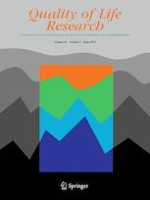13-02-2019
Patient versus proxy response on global health scales: no meaningful DIFference
Gepubliceerd in: Quality of Life Research | Uitgave 6/2019
Log in om toegang te krijgenAbstract
Purpose
Assessment of outcomes from a proxy is often substituted for the patient’s self-report when the patient is unable or unwilling to report their status. Research has indicated that proxies over-report symptoms on the patient’s behalf. This study aimed to quantify the extent of proxy-introduced bias on the Patient-Reported Outcomes Measurement Information System Global Health (PROMIS GH) scale for mental (GMH) and physical (GPH) scores.
Methods
This retrospective cohort study included incident stroke patients seen in a cerebrovascular clinic who completed PROMIS GH between 10/12/15 and 6/6/18. Differential item functioning (DIF) evaluated measurement invariance of patient versus proxy responses. DIF impact was assessed by comparing the initial score to the DIF-adjusted score. Subgroup analyses evaluated DIF within strata of stroke severity, measured by modified Rankin Scale (≤ 1, 2, 3+), and time since stroke (≤ 30, 31–90, > 90 days).
Results
Of 1351 stroke patients (age 60.5 ± 14.9, 45.1% female), proxy help completing PROMIS GH was required by 406 patients (30.1%). Proxies indicated significantly worse response to all items. No items for GMH or GPH were identified as having meaningful DIF. In subgroup analyses, no DIF was found by severity or 31–90 days post-stroke. In patients within 30 and > 90 days of stroke, DIF was detected for 2 items. Accounting for DIF had negligible effects on scores.
Conclusions
Our findings revealed the overestimation of symptoms by proxies is a real difference and not the result of measurement non-invariance. PROMIS GH items do not perform differently or have spuriously inflated severity estimates when administered to proxies instead of patients.
